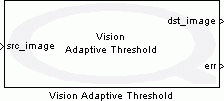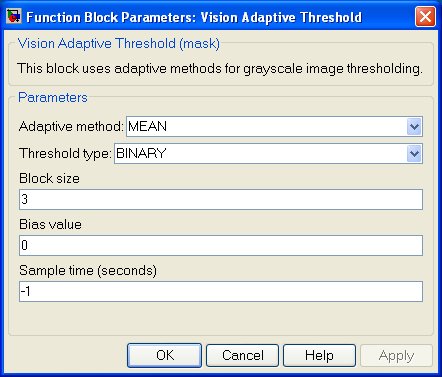

Vision Adaptive Threshold

|
This block is currently a beta version. If you are using this block, we would appreciate any feedback at tech@quanser.com. |
Segments a grayscale image.
Library
QUARC Targets Beta/Image Processing/Open Source Computer Vision MATLAB Command Line Click to copy the following command line to the clipboard. Then paste it in the MATLAB Command Window: qc_open_library('quarc_library_beta/Image Processing/Open Source Computer Vision')
Description

The Vision Adaptive Threshold block transforms a grayscale image into a binary image using adaptive thresholding methods.
In order to use this block, be sure to follow the instructions described on the Vision Capture Image page, and take careful note of the limitations.
Input Ports
src_image
A handle to a source image that uses OpenCV (Open Source Computer Vision) IplImage structure. If the input is a color image, this block converts it to a gray image and then employs adaptive thresholding techniques to generate an output binary image.
Output Ports
dst_image
Thresholded destination image in 8-bit binary format. Pixel values are either 0 or 255.
err
Negative signal value in case of memory allocation error.
Parameters and Dialog Box

Adaptive method
Specifies the adaptive thresholding algorithm to be used. The available options are MEAN and GAUSSIAN types.
Method MEAN refers to a mean of Block size × Block size pixel neighborhood, subtracted by a Bias value.
On the other hand, Method GAUSSIAN refers to a weighted sum (gaussian) of Block size × Block size pixel neighborhood,
subtracted by a Bias value.
Threshold type
Specifies the type of thresholding to be used. The options are BINARY and BINARY_INV. The options are described as follows:
BINARY:
dst_image(x,y) = 255, if src_image(x,y)>Adaptive Threshold
0, otherwise
BINARY_INV:
dst_image(x,y) = 0, if src_image(x,y)>Adaptive Threshold
255, otherwise
Block size
Specifies a size of a pixel neighborhood.
Bias value
Specifies a bias value to be used in the Adaptive method. It may be negative.
Sample time
The sample time of the block. A sample time of 0 indicates that the block will be treated as a continuous time block. A positive sample time indicates that the block is a discrete time block with the given sample time. A sample time of -1 indicates that the block inherits its sample time.
Targets
|
Target Name |
Compatible* |
Model Referencing |
Comments |
|---|---|---|---|
|
No |
No |
Not supported. |
|
|
No |
No |
Not supported. |
|
|
Yes |
Yes |
||
|
Yes |
Yes |
||
|
Yes |
Yes |
||
|
Yes |
Yes |
||
|
Yes |
Yes |
||
|
Yes |
Yes |
||
|
Yes |
Yes |
||
|
Yes |
Yes |
||
|
Yes |
Yes |
||
|
Yes |
Yes |
||
|
Yes |
Yes |
||
|
No |
No |
Not supported. |
|
|
Rapid Simulation (RSIM) Target |
No |
No |
Not supported. |
|
S-Function Target |
No |
N/A |
Old technology. Use model referencing instead. |
|
Normal simulation |
Yes |
Yes |
See Also

Copyright ©2025 Quanser Inc. This page was generated 2025-11-01. Submit feedback to Quanser about this page.
Link to this page.